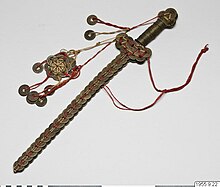
Coin-swords (alternatively spelt as coin swords), or cash-swords, are a type of Chinese numismatic charms that are a form of feng shui talisman that were primarily used in southern China to ward off evil spirits and malicious influences, especially those inducing fever.[1] These coin-swords are also often used in Taoist rituals. Coin-swords are considered an "evil-warding sword" (Chinese: 避邪劍; pinyin: bì xié jiàn) in China.[2]
Coin-swords usually consist of Qing dynasty era cash coins, specifically from the Kangxi and Qianlong eras, but may also be made from older cash coins.
Coin-swords were also often used by overseas Chinese communities, such as those living in the United States or in Canada, during the 19th and early 20th centuries and merchants and individuals would often purchase cash coins to bring them to these overseas communities to make them into wedding gifts.[3] Coin swords were commonly given to newlyweds to hang over the marriage bed as a means to insure bliss and harmony.[4][3] These coin-swords are typically an approximate length of 35 cm to 50 cm and require a minimum of 50 coins to make, while the older, larger, and more elaborately decorated coin-swords would typically contain around 150 cash coins.[3]
- ^ Doolittle 1868, p. 563.
- ^ Unlisted (8 January 2020). "The Chinese Coin Sword Is A Tool That Combats Aggressive Sha Chi". Fengshuied!. Retrieved 1 March 2020.
- ^ a b c Marjorie Kleiger Akin (1 June 1992). "The noncurrency functions of Chinese wen in America". Historical Archaeology. Retrieved 6 August 2023.
- ^ ARMENTROUT-MA, EVE (1984) Chinese Popular Religion. Booklet to accompany exhibit of the same name. C. E. Smith Anthropology Museum, California State University, Hayward, California.